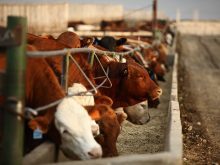MarketsFarm — The ICE Futures canola market may have seen some large price swings over the past few weeks, but remains relatively rangebound overall with values sitting just below their all-time highs.
The upward momentum is slowing down, said David Derwin, a commodities investment advisor with PI Financial in Winnipeg. However, he added, it remains to be seen if there will be a turnaround in the longer uptrend.
European rapeseed, Malaysian palm oil and Chicago soybean oil have all come into sideways patterns of their own over the past month, but Derwin noted past periods of stabilization in those markets over the past year have all eventually led to reestablishment of the uptrends.
Read Also

U.S. livestock: Chicago cattle, hogs rise
Chicago cattle and hog futures closed higher on Thursday. Most-active February live cattle futures settled at 230.950 cents a pound,…
The canola market typically sees its seasonal peaks in late June or early July, but weather uncertainty may disrupt that pattern this year, said Derwin.
Mixed conditions across the Canadian Prairies were likely keeping some caution in the canola market for the time being. While a few areas had a good start to the season, others were too dry and others too wet, with seeding still well behind normal in Manitoba.
China’s recent move to lift restrictions on canola imports from Viterra and Richardson should also be supportive, as “it’s basically saying that they want to have access to more canola products.”
Outside influences such as Russia’s invasion of Ukraine, Indonesia’s palm oil policy, Chinese demand and India’s wheat export restrictions will all be factors to watch going forward.
Amid that backdrop, Derwin said prices for grains and oilseeds in general appear to be pointed higher, although he cautioned the sentiment could quickly change.
“The weather says it’s got to go higher, demand says it’s got to go higher, and supply says it’s got to go higher, but if the charts and price patterns say it’s not going higher — you have to be ready to capture these prices.”
— Phil Franz-Warkentin reports for MarketsFarm from Winnipeg.
















